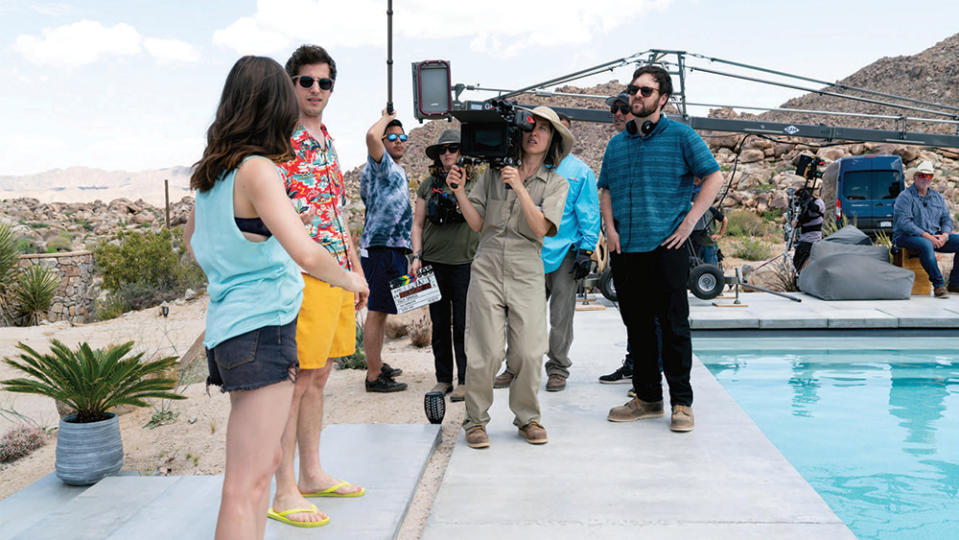‘Palm Springs’ Cinematographer Describes the Moment She Knew She ‘Had to Be a Part of This Film’

Click here to read the full article.
Cinematographer Quyen Tran was hooked the minute she read the script for “Palm Springs,” Max Barbakow’s feature directorial debut that’s now streaming on Hulu. “I saw the words ‘car chases,’ ‘plane crashes’ and ‘dinosaurs’ and knew I had to be a part of this film,” she says.
The movie, written by Andy Siara, stars Andy Samberg and Cristin Milioti as Nyles and Sarah, who meet at a wedding in the titular California desert city and soon find themselves stuck in a “Groundhog Day”-like time loop that often leaves them looking for spectacular escapes. But Tran and Barbakow focused on relationships, not action, in their early strategy sessions.
More from Variety
“We spent a lot of time talking about theme and character, designing the movie from the inside out — not imposing a style but creating our own out of disparate touchstones,” Barbakow says. “She intimately understood the importance of the human element in this movie.”
Tran used anamorphic lenses to shoot the entire project, citing the visual influence of Paul Thomas Anderson’s 2002 dark romantic comedy “Punch Drunk Love,” which centered on a man with social anxiety who attempts to go on a date. The idea was to focus in on the protagonists by giving the shots some fuzziness at the edges — “and to bring out the film’s darker, existential themes.” Tran shot with T Series anamorphics, which she had just used on the documentary “Wildflower,” about a family dynamic turned upside down. “The lens characteristics provide a more surreal element,” says the DP, “which is just what the script suggests.”
Tran sweat the small stuff. She relied on camera angles to immediately let viewers know of the intertwined fates of the two leads. To establish the image of the characters waking up again in the same day, Nyles looks camera right and Sarah camera left in their respective scenes. “I tried to perfectly match the lens focal distance to our subject so that you would know instantly without any other indicator that we are back at the same bed, the same location, the same morning and moment in time,” she explains.
The DP leaned on lighting as a way to depict the two characters’ different emotional states. Sarah’s room was dimly lit with a single shaft of illumination to show the viewer the sadness in her soul at the start. “It looks like a very dark place to wake up, both physically and mentally,” Tran explains. In contrast, “Nyles wakes up in a very bright and cheerful place,” oblivious to his situation.
Tran says she also chose to show the heat of Palm Springs, setting up outside in glaring daylight. “We were out there shooting with no coverage and in the full sun,” she says. “We didn’t want to beautify it at all,” even if that meant getting hard shadows in the process.
The most challenging scene to film was the one at the house where Nyles is staying, when Sarah experiences her first day in the time loop. She confronts a floating Nyles and demands an explanation, then pelts him with beer cans and jumps into the water to continue the attack. Tran had four hours to shoot the scene on location, including the action underwater. And she needed to consider both characters’ perspectives to tell the story.
She built a meticulous shot list that helped underwater operator Robert Settlemire (“Booksmart”) capture the needed images. She also brought in the heavy artillery, using two additional cameras — a handheld on the ground and another that could capture the action from above. “That was so crazy,” Tran says, “but we got the third camera for that sequence, put it on a technocrane and everything was done to a T.”
Lighting was also integral to the work in the cave, in a nearby tent and during a scene in which the pair ingest hallucinogens and imagine they’re seeing dinosaurs. Since starting a fire around the cavern area was prohibited, the DP instead chose a fire-like radiance to illuminate the surroundings.
“We used it in only very specific instances,” Tran says. “The orange glow of the cave became a symbol of hope and love.”
Sign up for Variety’s Newsletter. For the latest news, follow us on Facebook, Twitter, and Instagram.

 Yahoo Finance
Yahoo Finance 